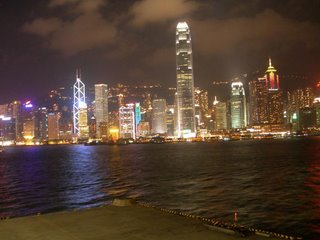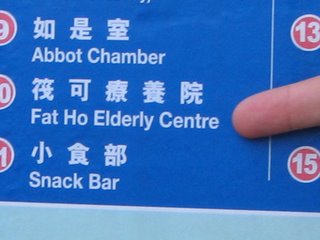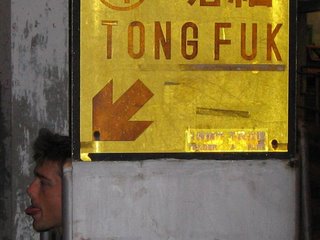After leaving Saigon, we docked in Singapore for a day to refuel. Leaving the tip of the Malaysian peninsula, we went up through the Straight of Malacca which is a very thing strip of water between Malaysia and Indonesia. It is also the most heavily pirated body of water in the world.
At the beginning of the trip the rumor was that we had a private security detail onboard with a full-blown armory on the eighth deck. In case of a pirate attack, security officers would man machine guns and protect the ship. Well unfortunately it turns out that we do not have any big guns onboard, and that our only weapon against pirates is in fact high-pressure water hoses.
Apparently two years ago there was a group of pirates that attempted to board the ship. They tried to throw ropes up to the fifth deck to climb and the crew was easily able to keep them off the ship by spraying them from above. The accounts I’ve heard about the pirates make them sound like a rag-tag bunch of idiots. I’m guessing that they can rob little fishing boats, but can’t really do much with a big ship like ours.
We had students on alternating four-hour shifts of “pirate watch” from the top deck throughout the passage of the Straight. We heard that one small boat did in fact come close and scope our ship out, but then left. Aargggh!
Friday, October 20, 2006
Wednesday, October 11, 2006
Khmer Rouge
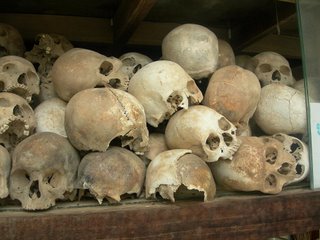
Cambodia has a grizzly recent past, one that I had never heard about before stepping foot in Phnom Penh. Apparently, not many other of my peers had either. This trip has been similar to my college education in that the more I learn, the more I realize how much I don’t know.
So here is the story as I was able to put it together. During the Vietnam-America war, America bombed part of the Ho Chi Minh trail that went through Cambodia. Cambodia’s government was weak and the spillover of fighting was enough to disturb the fragile state. As a result, a group known as the Khmer Rouge (Red Cambodians) came to power, under the leadership of a guy named Pol Pot.
The Khmer Rouge had the goal of turning Cambodia into an agricultural “workers paradise”. They emptied the cities by killing anyone that attempted to stay. They killed anyone that appeared educated. Teachers, doctors, and even monks were killed. If somebody was wearing glasses, they would kill them. The killing was systematic and organized.
After the defeat of America, Vietnam was already in military mode. They went into Cambodia and were able to kick out the Khmer Rouge in 1978. When all was said and done, between 1 and 3 million people had been killed.
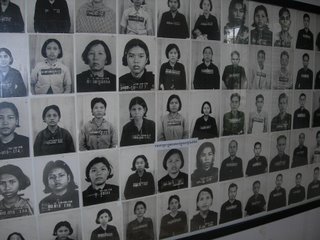
When we were in Phnom Penh, we visited a high school that had been converted into a prison. The Khmer Rouge was extremely unstable and high ranking officials were often accused and killed for being traitors. There was even a whole section of the prison that was dedicated to “VIP” prisoners. There were tons of torture devices left in the prison.
After seeing the prison, we went to the killing fields. These had been discovered in the 1980’s. Thousands of remains were found here. There are hundreds of fields like the one we saw scattered all around Cambodia, and more are being found. There was a monument, and inside were thousands human skulls stacked three stories high.
Cambodians are extremely docile people. They were an easy target to terrorize, as they would not fight to defend themselves. It is awful that no other country stepped in when this was going on. I can see why the United States would not want to right after being defeated in Vietnam, but somebody should have done something. People always talk about “fighting for peace”, and this is a crock of shit. The Khmer Rouge was not a particularly strong regime. This would have been a clean cut and relatively easy war for peace, yet nobody took it up. Cambodia was extremely poor, and had nothing to offer the victors, so nobody did anything to stop the genocide.
Pol Pot and the rest of the Khmer Rouge were pushed into a lawless and uncontrolled region in the mountains by the Thai border when Vietnam took over. Many of them still live there, and have not been tried for their crimes. Pol Pot recently died of old age in his compound in the mountains. Like I said, Cambodia has nothing to offer politically or financially, so everybody just looks the other way.
Seeing these places was extremely hard to take. It is hard to imagine how
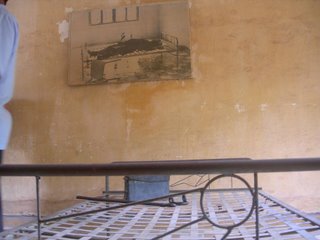 big a group of 2 million people is. Edison Field sells out at around 50,000, so you would need 40 Edison Field’s to house all of the people that were killed. You can see a kind of sorrow in a lot of the older people in Cambodia who went through this. I can’t believe that in my 16 years of education I had never heard of the Cambodian genocide. What a joke. The things I saw this day will stick with me for a long long time.
big a group of 2 million people is. Edison Field sells out at around 50,000, so you would need 40 Edison Field’s to house all of the people that were killed. You can see a kind of sorrow in a lot of the older people in Cambodia who went through this. I can’t believe that in my 16 years of education I had never heard of the Cambodian genocide. What a joke. The things I saw this day will stick with me for a long long time.
Siem Reip
After exploring the temples all morning everyone was heading back to Angkor Wat, where we had been at sunrise. I wanted to find some throat lozenges to alleviate the sore throat I had developed, so I split off until lunch.
I was at a small dirt clearing with some hut style shops at the exit of one of the temples. First things first, I had to find a bathroom. I asked a lady selling T-shirts, and she said “It’s OK, you go jungle” and pointed to the trees. I’m fine with that, I just didn’t want offend anybody by urinated on the site of these sacred temples.
After taking care of business, I had to find a way to get back into town. The lone rickshaw driver was passed out in the back seat of his rig, so I left him alone. It seems that in Cambodia and Vietnam, any guy on a scooter is willing to take you where you need to go. Even if a guy on the street does not have a scooter, he can probably get one. I found a guy selling postcards and asked him if he could take me into town. He told me to wait, and a few minutes later he showed up with a scooter.
The ride into town was awesome. The left foot peg was broken off, so I had to hold onto my foot like a chicken wing. Flying through the jungle on Cambodia jungle roads reminded me of being back on my dirt bike. We got pushed into the weeds a few times by big trucks and almost had one head-on with a car, but close calls are what make life fun.
Back in town I asked around and located a pharmacy. Walking through town alone, I got nothing but smiles. When you are not with a group you feel more like you belong. With a few other people, you look like a group of outsiders. If you are walking around alone, you must know what you are doing right? Whatever the case, I felt totally at ease and comfortable in Siem Reip. It still feels surreal a lot of the time. With a stupid grin, I kept saying to myself, “Wow, I’m really in Cambodia right now.”
I was at a small dirt clearing with some hut style shops at the exit of one of the temples. First things first, I had to find a bathroom. I asked a lady selling T-shirts, and she said “It’s OK, you go jungle” and pointed to the trees. I’m fine with that, I just didn’t want offend anybody by urinated on the site of these sacred temples.
After taking care of business, I had to find a way to get back into town. The lone rickshaw driver was passed out in the back seat of his rig, so I left him alone. It seems that in Cambodia and Vietnam, any guy on a scooter is willing to take you where you need to go. Even if a guy on the street does not have a scooter, he can probably get one. I found a guy selling postcards and asked him if he could take me into town. He told me to wait, and a few minutes later he showed up with a scooter.
The ride into town was awesome. The left foot peg was broken off, so I had to hold onto my foot like a chicken wing. Flying through the jungle on Cambodia jungle roads reminded me of being back on my dirt bike. We got pushed into the weeds a few times by big trucks and almost had one head-on with a car, but close calls are what make life fun.
Back in town I asked around and located a pharmacy. Walking through town alone, I got nothing but smiles. When you are not with a group you feel more like you belong. With a few other people, you look like a group of outsiders. If you are walking around alone, you must know what you are doing right? Whatever the case, I felt totally at ease and comfortable in Siem Reip. It still feels surreal a lot of the time. With a stupid grin, I kept saying to myself, “Wow, I’m really in Cambodia right now.”
Temples of Angkor

The Temples of Angkor are about 10-20 miles outside of Siem Reip. These are the most beautiful ruins I have ever seen. Many of the temples have been reconstructed, and you can roam freely throughout the stone hallways and dark rooms.
The first temple we visited was Angkor Wat. This is the famous one that you see in pictures. We got there before sunrise, and Nick and I went straight from the main entrance to the large complex in back. The buildings were empty except for a couple Cambodian men lighting incense at statues of Buddha tucked away in dark corners. The complex is open to climb and explore, and it was a cool experience to explore ancient stone ruins alone in the dark.
We also visited a temple that has not been touched or reconstructed at all. Huge trees grow on top of the complex with fascinating root structures that have penetrated walls and entangle large sections of the temple.
The thing that was really interesting to me was the mixture of Hindu
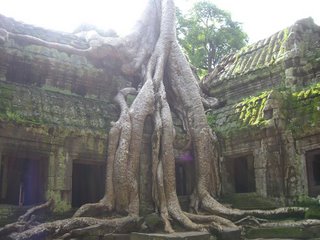 and Buddhist influence. When the first temples were built, the area that is now Cambodia was predominately Hindu. They were built with beautiful statues and carvings of Hindu gods. Later on the area shifted to become predominately Buddhist, as it is today. The emperors that came to power modified the temples with statues of Buddha, but in many cases left the Hindu influence. It is fascinating to see such a mixture of Hinduism and Buddhism in the same structures. The ancient Khmers must have been very tolerant people. I find it hard to believe that any Catholics or Christians would ever tolerate Hindu carvings on their buildings.
and Buddhist influence. When the first temples were built, the area that is now Cambodia was predominately Hindu. They were built with beautiful statues and carvings of Hindu gods. Later on the area shifted to become predominately Buddhist, as it is today. The emperors that came to power modified the temples with statues of Buddha, but in many cases left the Hindu influence. It is fascinating to see such a mixture of Hinduism and Buddhism in the same structures. The ancient Khmers must have been very tolerant people. I find it hard to believe that any Catholics or Christians would ever tolerate Hindu carvings on their buildings.The temples of Angkor are fascinating, and there are so many in the area that you can explore for a week without visiting the same one twi
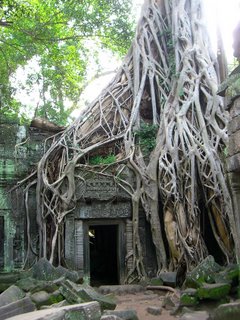 ce.
ce. 
Landmines
Cambodia was heavily landmined during the Vietnam-America War and during the reign of the Khmer Rouge. It is estimated that 10 million landmines have been planted in Cambodia, and 4 million uncharted landmines still exist today. Everyday numerous people are killed or injured by landmines.
The landmines have taken a horrible toll on Cambodia. As soon as we arrived in Pnom Penh, the number of amputees was overwhelming. You can’t walk for two minutes without seeing somebody who has lost a limb to a landmine, it is that bad. I saw one man who was not an amputee, but had been burned all over the front of his body. He had lost an eye and his face was unrecognizable. It is absolutely tragic that normal citizens going about their daily lives are the victims of these awful weapons.
The landmines have taken a horrible toll on Cambodia. As soon as we arrived in Pnom Penh, the number of amputees was overwhelming. You can’t walk for two minutes without seeing somebody who has lost a limb to a landmine, it is that bad. I saw one man who was not an amputee, but had been burned all over the front of his body. He had lost an eye and his face was unrecognizable. It is absolutely tragic that normal citizens going about their daily lives are the victims of these awful weapons.
Phnom Penh
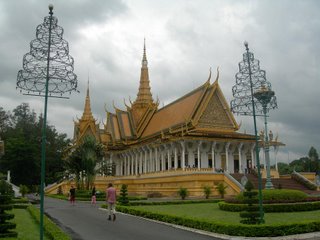
Phnom Penh (pronounced nom pen) is the capital of Cambodia. While we were in Phnom Penh we visited the king’s palace, which also has a mixture of Buddhist and Hindu influence. Outside of the palace is the king’s garden. It isn’t much of a garden but more of a little grass and patio area. There were a big group of kids playing a game of soccer in the middle of the patio, and apparently they weren’t supposed to be there. Every once in a while a police officer would come by and they would all run away, and then come back a few minutes later and keep playing.
We checked out the Cambodia national history museum, and got to see some artifacts that were from 200-400 B.C. That’s pretty old!
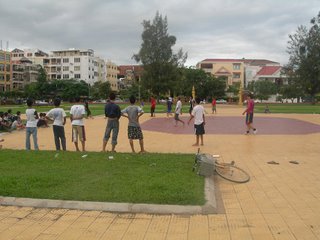
We also took a boat ride down to the Mekong River at sunset. There are many houses built on stilts extending out into the river. I assume that this because the people who live there can’t to pay for land, but I could be wrong. Everyone we saw along the river smiled and waved.

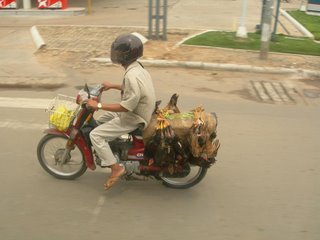
Cambodians
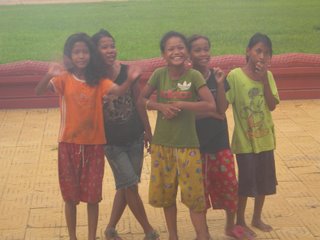
Cambodia is home to some of the warmest and kindest people in the world. It is also the poorest place I have ever visited.
Even though most people are poor, they are very happy and friendly. Big smiles greeted me wherever I went, especially from little kids playing in the street. This country directly contradicts the American point of view that I have grown up with; it is amazing how people with so little can be so happy.
It’s hard to really describe Cambodian life here, but what I saw is truly exceptional.
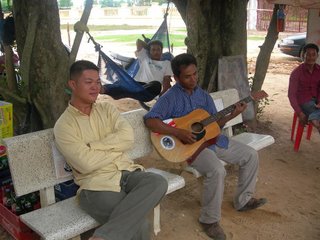
Tuesday, October 03, 2006
Cu Chi Tunnels
Tyler, Tayler and I spent a day at the Cu Chi tunnels, which is the tunnel system that the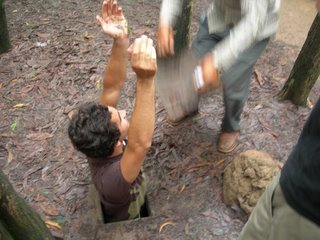 Viet Cong used during the war. I had recently red Tim O’Brien’s “The Things They Carried” and was really excited to see the tunnels. If you haven’t read this book you should, it is a beautifully written book that takes place during the Vietnam War.
Viet Cong used during the war. I had recently red Tim O’Brien’s “The Things They Carried” and was really excited to see the tunnels. If you haven’t read this book you should, it is a beautifully written book that takes place during the Vietnam War.
To get there we talked to a moto driver named Woang on the corner. He called his brother who had a car and drove us for a total of about 4 hours for 12 bucks each. Woang was from Cambodia, and had fled to Vietnam in the 70’s. He said that most of his friends had been killed in Cambodia. I wasn’t sure what he meant. I would find out a few days later in Cambodia what he was talking about, and this put another exclamation point on how ignorant I am.
The tunnels we visited were about an hour outside of Saigon. The entries to some of the tunnels are so small that none of us could fit our shoulders through them. They are so cramped, I can’t imagine living down there all the time. It must have been so scary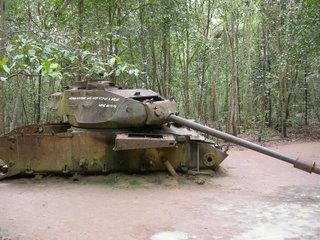 for Americans to have to crawl in there when they discovered a new tunnel. Being in the jungle made me feel how scary it must have been to be in that war. We saw an American tank that had been destroyed by a mine in 1970.
for Americans to have to crawl in there when they discovered a new tunnel. Being in the jungle made me feel how scary it must have been to be in that war. We saw an American tank that had been destroyed by a mine in 1970.
This may seem inappropriate, but we had a chance to shoot some automatic weapons while we were in Cu Chi. We got to shoot an AK-47 and the M-16’s that Americans used in the war. I’ve never been a firearms enthusiast, I don’t like to kill animals, and guns scare the crap out of me, but I didn’t think I would ever get this kind of chance again. These guns are extremely loud! I can’t imagine being shot at with these things. It must be absolutely terrifying. In a firefight you wouldn’t even be able to here yourself think. Fighting in this war must have been unbelievably scary.
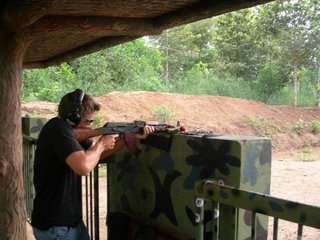
We also got to see examples of the booby traps that the Viet Cong used in the jungle. These were absolutely brutal. They made ditches with bamboo spears in the bottom, and would smear feces on the spears to promote infection. I can’t imagine how horrible this war must have been.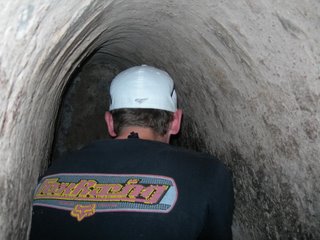
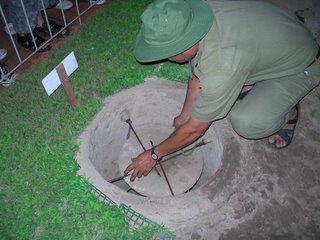
 Viet Cong used during the war. I had recently red Tim O’Brien’s “The Things They Carried” and was really excited to see the tunnels. If you haven’t read this book you should, it is a beautifully written book that takes place during the Vietnam War.
Viet Cong used during the war. I had recently red Tim O’Brien’s “The Things They Carried” and was really excited to see the tunnels. If you haven’t read this book you should, it is a beautifully written book that takes place during the Vietnam War.To get there we talked to a moto driver named Woang on the corner. He called his brother who had a car and drove us for a total of about 4 hours for 12 bucks each. Woang was from Cambodia, and had fled to Vietnam in the 70’s. He said that most of his friends had been killed in Cambodia. I wasn’t sure what he meant. I would find out a few days later in Cambodia what he was talking about, and this put another exclamation point on how ignorant I am.
The tunnels we visited were about an hour outside of Saigon. The entries to some of the tunnels are so small that none of us could fit our shoulders through them. They are so cramped, I can’t imagine living down there all the time. It must have been so scary
 for Americans to have to crawl in there when they discovered a new tunnel. Being in the jungle made me feel how scary it must have been to be in that war. We saw an American tank that had been destroyed by a mine in 1970.
for Americans to have to crawl in there when they discovered a new tunnel. Being in the jungle made me feel how scary it must have been to be in that war. We saw an American tank that had been destroyed by a mine in 1970.This may seem inappropriate, but we had a chance to shoot some automatic weapons while we were in Cu Chi. We got to shoot an AK-47 and the M-16’s that Americans used in the war. I’ve never been a firearms enthusiast, I don’t like to kill animals, and guns scare the crap out of me, but I didn’t think I would ever get this kind of chance again. These guns are extremely loud! I can’t imagine being shot at with these things. It must be absolutely terrifying. In a firefight you wouldn’t even be able to here yourself think. Fighting in this war must have been unbelievably scary.

We also got to see examples of the booby traps that the Viet Cong used in the jungle. These were absolutely brutal. They made ditches with bamboo spears in the bottom, and would smear feces on the spears to promote infection. I can’t imagine how horrible this war must have been.


Bargaining
There are tons of shops in Saigon, and nothing has a price tag. The Ben Tanh market was a really fun place to go at night. They sell tons of knock-off designer stuff. Everything can be bargained, and we learned to bargain pretty well.
The first thing to do is when you get a price, through your hands up and repeatedly say how expensive that is. Then say something like “I’m offended that you would try to rip me off like that”. Then you make an offer that is about a quarter of that price. It is really fun going back and forth. A pair of $20 dollar jeans was bargained down to two pairs for $22. The ladies in the markets were all really nice, and laughed and had a good time while we were bargaining. Taylor offered 2 bucks for a 5 dollar shirt, and one lady pretended to faint and fell on a pile of pants. It was hilarious.
One item that wasn’t up for bargain was DVD’s. They were set at a dollar a piece, and I bought 25 for myself, including a few titles that are still in theatres.
The first thing to do is when you get a price, through your hands up and repeatedly say how expensive that is. Then say something like “I’m offended that you would try to rip me off like that”. Then you make an offer that is about a quarter of that price. It is really fun going back and forth. A pair of $20 dollar jeans was bargained down to two pairs for $22. The ladies in the markets were all really nice, and laughed and had a good time while we were bargaining. Taylor offered 2 bucks for a 5 dollar shirt, and one lady pretended to faint and fell on a pile of pants. It was hilarious.
One item that wasn’t up for bargain was DVD’s. They were set at a dollar a piece, and I bought 25 for myself, including a few titles that are still in theatres.
Transportation
The way traffic operates in Vietnam kept a constant grin on my face. Everyone rides scooters because they are an inexpensive form of transportation. There are probably 20 scooters to every car. The streets are flooded with them! The bummer is that nobody wears helmets. Our diplomat told us that there are 1000 traffic related deaths a month, which is around thir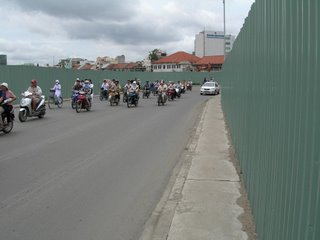 ty a day. I can’t remember if he was talking about Vietnam as a whole or Saigon specifically, but that number could easily be brought down to five deaths a day if everyone wore helmets.
ty a day. I can’t remember if he was talking about Vietnam as a whole or Saigon specifically, but that number could easily be brought down to five deaths a day if everyone wore helmets.
The streets are a free-for-all. There are some traffic lights, but they are not really adhered to. The only pattern to the madness is that most riders have a slight preference to the right side of the road. At intersections, groups of riders form up that are stopped and edge out into the road until they stop the cross traffic and then they take off. It’s really funny to watch, big groups will form and then just go right into oncoming traffic.
To cross the street, you need to have faith. If you use your head you will get hit. The traffic never stops, so you walk at a normal pace and in a straight line right into it. It is super scary, but everyone rides right around you. If you change your pace or try to avoid a scooter, you will get hit. Don’t run, don’t stop, don’t panic, just look at the ground, walk s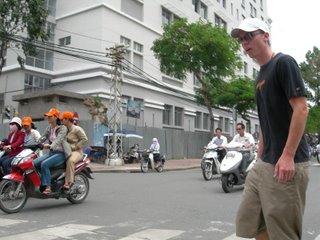 lowly and hold your line.
lowly and hold your line.
Scooters are the best form of transport in Saigon, and there are guys on every street waiting to pick you up. They call them “motos” and all you have to do is twist your wrist and hop on the back, and they’ll take you anywhere for a dollar. The metered taxis are BS, and this jerk tried to charge us 20 bucks for a 2 dollar cab ride. After a five minute screaming match, we settled on 7 and left. After that I only took the motos.
The first moto ride I took was after having a great time at a club appropriately named “Apocalypse Now”. It was at night and raining and I was still buzzing from having a good time. A few others and I hopped on the back of the scooters to get back to the ship. Flying through the streets of Saigon was so fun. Leaned over in the turns, crossing wet railroad tracks, I was just waiting for the familiar sound of crunching metal. Carl, the other cyclist on the ship, was right in front of me so I’m sure he was thinking the same thing. Those guys have been doing their jobs for many years, so they know what they are doing. We got back fast and safe, so after that I was sold.
The other option for transportation around Saigon is the more antiquated “cyclos”. A cyclo is a three wheeled rick-shaw that is peddled like a bicycle. Many of th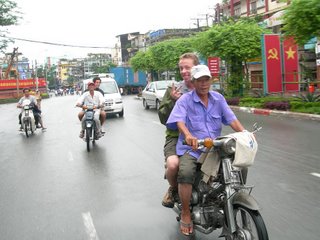 ese drivers were stripped of their citizenship after the war for siding with America. Some used to be doctors, teachers, etc. but now are considered illegal in the city, so this is how they support themselves. Riding in these quiet and smooth machines is very strange on the busy streets. It feels like you are in fifty years in the past, very different from all the madness of the traffic around you.
ese drivers were stripped of their citizenship after the war for siding with America. Some used to be doctors, teachers, etc. but now are considered illegal in the city, so this is how they support themselves. Riding in these quiet and smooth machines is very strange on the busy streets. It feels like you are in fifty years in the past, very different from all the madness of the traffic around you.
Like the motos, the cyclos cost a dollar to go anywhere. Having not ridden a bike in a while, I paid my cyclo driver three bucks to let me drive while he rode along. It was great fun and all of the other drivers cracked up when they watched me in the main parking lot. The cyclo driver responded with “You very good, when you done student, you come Saigon, I give job.” I think it would be a hell of a lot of fun.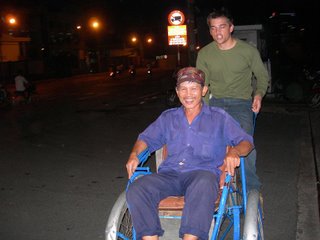
 ty a day. I can’t remember if he was talking about Vietnam as a whole or Saigon specifically, but that number could easily be brought down to five deaths a day if everyone wore helmets.
ty a day. I can’t remember if he was talking about Vietnam as a whole or Saigon specifically, but that number could easily be brought down to five deaths a day if everyone wore helmets.The streets are a free-for-all. There are some traffic lights, but they are not really adhered to. The only pattern to the madness is that most riders have a slight preference to the right side of the road. At intersections, groups of riders form up that are stopped and edge out into the road until they stop the cross traffic and then they take off. It’s really funny to watch, big groups will form and then just go right into oncoming traffic.
To cross the street, you need to have faith. If you use your head you will get hit. The traffic never stops, so you walk at a normal pace and in a straight line right into it. It is super scary, but everyone rides right around you. If you change your pace or try to avoid a scooter, you will get hit. Don’t run, don’t stop, don’t panic, just look at the ground, walk s
 lowly and hold your line.
lowly and hold your line.Scooters are the best form of transport in Saigon, and there are guys on every street waiting to pick you up. They call them “motos” and all you have to do is twist your wrist and hop on the back, and they’ll take you anywhere for a dollar. The metered taxis are BS, and this jerk tried to charge us 20 bucks for a 2 dollar cab ride. After a five minute screaming match, we settled on 7 and left. After that I only took the motos.
The first moto ride I took was after having a great time at a club appropriately named “Apocalypse Now”. It was at night and raining and I was still buzzing from having a good time. A few others and I hopped on the back of the scooters to get back to the ship. Flying through the streets of Saigon was so fun. Leaned over in the turns, crossing wet railroad tracks, I was just waiting for the familiar sound of crunching metal. Carl, the other cyclist on the ship, was right in front of me so I’m sure he was thinking the same thing. Those guys have been doing their jobs for many years, so they know what they are doing. We got back fast and safe, so after that I was sold.
The other option for transportation around Saigon is the more antiquated “cyclos”. A cyclo is a three wheeled rick-shaw that is peddled like a bicycle. Many of th
 ese drivers were stripped of their citizenship after the war for siding with America. Some used to be doctors, teachers, etc. but now are considered illegal in the city, so this is how they support themselves. Riding in these quiet and smooth machines is very strange on the busy streets. It feels like you are in fifty years in the past, very different from all the madness of the traffic around you.
ese drivers were stripped of their citizenship after the war for siding with America. Some used to be doctors, teachers, etc. but now are considered illegal in the city, so this is how they support themselves. Riding in these quiet and smooth machines is very strange on the busy streets. It feels like you are in fifty years in the past, very different from all the madness of the traffic around you.Like the motos, the cyclos cost a dollar to go anywhere. Having not ridden a bike in a while, I paid my cyclo driver three bucks to let me drive while he rode along. It was great fun and all of the other drivers cracked up when they watched me in the main parking lot. The cyclo driver responded with “You very good, when you done student, you come Saigon, I give job.” I think it would be a hell of a lot of fun.

I Love Vietnam!
Vietnam is a wonderful place with wonderful people. We docked in Ho Chi Minh City which is also referred to as Saigon. This is the main city in southern Vietnam, with the capital being Hanoi in the North.
Saigon was not as poor as I imagined it would be. I would say it is a step up from Beijing. There are not many beggars. The people are very industrious, and everybody seems to be working or selling something. It is a super busy place, with lots of energy.
The Vietnamese people are so friendly. Everyone that I came into contact with had a big smile on their face. They don’t have a lot of money, but they seem content. I asked a 52-year-old moto driver about his job, and he said it was nice because if he didn’t feel like work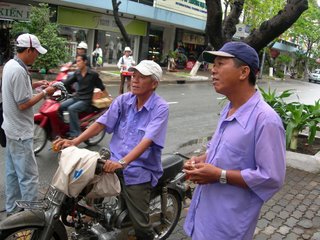 ing, then he could just stay home. They aren’t concerned with getting ahead and making lots of money. They take things slower and enjoy life. Their philosophy seems to be working, because people are always laughing. There are not a lot of billboards and advertisements. The rabid consumerism in America is not found here. The people seem to be much happier for it. It makes me sad that such kind and gentle people had to go through such a horrible war.
ing, then he could just stay home. They aren’t concerned with getting ahead and making lots of money. They take things slower and enjoy life. Their philosophy seems to be working, because people are always laughing. There are not a lot of billboards and advertisements. The rabid consumerism in America is not found here. The people seem to be much happier for it. It makes me sad that such kind and gentle people had to go through such a horrible war.
The currency in Vietnam is the Vietnamese Dong. As immature as it is, it never failed to get a laugh for our whole stay. The exchange rate is about 16,000 dong for one dollar. U.S. cash is accepted everywhere, and I actually never exchanged any money during my stay. The prices are very cheap. A nice sit down meal with appetizers and drinks never got over seven dollars.
Vietnam is a communist country. I didn’t see any military while I was there. The various government officials that I did see were sitting on their asses all the time. It appeared that they were getting paid for doing nothing.
English is widely spoken in Saigon. This is good because like Chinese, I could grasp very little of the Vietnamese language.
The food in Vietnam was super delicious. One of my favorites was Pho (pronounced f-uh) which is a soup with noodles and all sorts of other veggies and meat in it. There were also lots of good dishes with seafood, fried noodles, and some good curries.
My stay in Vietnam was such a great time. I don’t think that it is common to go to a foreign country and feel welcomed and completely at ease. I definitely didn’t feel like this at our previous stops. I have nothing but good things to say about this country.
Saigon was not as poor as I imagined it would be. I would say it is a step up from Beijing. There are not many beggars. The people are very industrious, and everybody seems to be working or selling something. It is a super busy place, with lots of energy.
The Vietnamese people are so friendly. Everyone that I came into contact with had a big smile on their face. They don’t have a lot of money, but they seem content. I asked a 52-year-old moto driver about his job, and he said it was nice because if he didn’t feel like work
 ing, then he could just stay home. They aren’t concerned with getting ahead and making lots of money. They take things slower and enjoy life. Their philosophy seems to be working, because people are always laughing. There are not a lot of billboards and advertisements. The rabid consumerism in America is not found here. The people seem to be much happier for it. It makes me sad that such kind and gentle people had to go through such a horrible war.
ing, then he could just stay home. They aren’t concerned with getting ahead and making lots of money. They take things slower and enjoy life. Their philosophy seems to be working, because people are always laughing. There are not a lot of billboards and advertisements. The rabid consumerism in America is not found here. The people seem to be much happier for it. It makes me sad that such kind and gentle people had to go through such a horrible war.The currency in Vietnam is the Vietnamese Dong. As immature as it is, it never failed to get a laugh for our whole stay. The exchange rate is about 16,000 dong for one dollar. U.S. cash is accepted everywhere, and I actually never exchanged any money during my stay. The prices are very cheap. A nice sit down meal with appetizers and drinks never got over seven dollars.
Vietnam is a communist country. I didn’t see any military while I was there. The various government officials that I did see were sitting on their asses all the time. It appeared that they were getting paid for doing nothing.
English is widely spoken in Saigon. This is good because like Chinese, I could grasp very little of the Vietnamese language.
The food in Vietnam was super delicious. One of my favorites was Pho (pronounced f-uh) which is a soup with noodles and all sorts of other veggies and meat in it. There were also lots of good dishes with seafood, fried noodles, and some good curries.
My stay in Vietnam was such a great time. I don’t think that it is common to go to a foreign country and feel welcomed and completely at ease. I definitely didn’t feel like this at our previous stops. I have nothing but good things to say about this country.
Monday, October 02, 2006
Hong Kong

My last day was spent back in Hong Kong. Our ship was docked in an area called Kowloon. I felt obligated to go to Hong Kong Island which is the big city area, but I was pretty burnt out on the big city life. Instead, Tyler, Darcy, Sophie and I took the ferry to Lantau Island to get away for a while.
The island is covered in a beautiful forest that reminded me of Costa Rica. The big attraction on Lantau is the world’s biggest Buddha statue.
After gazing at the big Buddha for a while, we started our assault on Lantau peak, the highest point on the island. It took us about two hours to reach the top, and it was well worth it. The hike was comparable to what we had done on the Great Wall a couple days before. The winds were blowing around 50 mph at the top. The views were amazing.

On our way back down, we stopped at a Buddhist monastery that was serving all vegetarian food. They had all sorts of amazing things made out of tofu and bean curd. It was pretty dang good and the stomach was pleased to have a break from pork and beef.

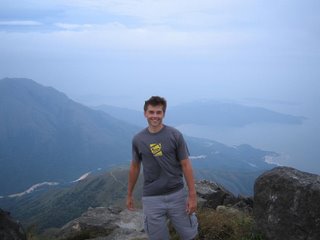
Chinese
Chinese is a very, very tough language. The whole time I learned a total of two words. Even when somebody was sitting with me trying to teach me how to say something simple like “where is the bathroom”, I couldn’t understand the sounds, let alone repeat them. I couldn’t tell a single difference between the Mandarin dialect spoken in Beijing and the Cantonese spoken in Hong Kong, it all sounded like gibberish to me.
One thing that I noticed is that the Chinese language does not use any L’s. Because of this, English-speaking Chinese could not pronounce the “L” sound, and used and R instead. The “Great Wall” was pronounced “Great War” and “Hello” was “Harro”. It is interesting how the sounds used by one’s primary language dictate the accent that one has in another language.
One thing that I noticed is that the Chinese language does not use any L’s. Because of this, English-speaking Chinese could not pronounce the “L” sound, and used and R instead. The “Great Wall” was pronounced “Great War” and “Hello” was “Harro”. It is interesting how the sounds used by one’s primary language dictate the accent that one has in another language.
Acrobat Show
We went to a Chinese Acrobat show. The physics just didn’t add up behind some of the stuff I saw. Check out the picture of about a billion Chinese chicks on one bicycle. That’s a cool trick! The guy riding a unicycle across a tight rope balancing on his head and peddling with his hands was pretty cool too.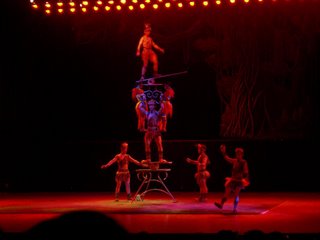





Communism
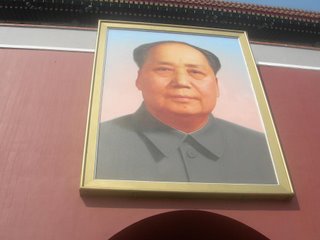
China was the first communist country I have ever been too. At first it didn’t seem too different, but I started noticing little things along the way.
The most obvious was the military presence. In Tiananmen Square, there were soldiers marching all over the place. They flipped out when I started to point my camera at them, so I had to shoot a few sneak shots from the hip. Inevitably, a trip to Tiananmen Square will bring up questions about the 1989 massacre. The students that we were with from Peking University would not even acknowledge any of these questions. Anyone asked would just pretend like you hadn’t said anything. The government keeps that under tight wraps, and people just don’t talk about those kinds of things.
If you pay attention, you will start to notice that there are cameras everywhere. Mao is watching you!

One of the things that initially turned me on about China was the lack of pop culture being in your face all the time. This was in excess in Japan, and really wore me out. At first I figured that it was just because there wasn’t a whole lot of money to be spent. But as the trip went on, I started realizing that the government really controls the media. The newspapers really tipped me off to this. The big front page stories that I saw were about a boy who got injured by a needle that was left in his pants pocket, and the other was about a man who jumped into a cage at the zoo and bit a panda bear. No doubt these are very important stories, but when I got back to Hong Kong and read the paper, I was kind of wondering why there hadn’t been a front page story about the military coup that took place in Thailand the day before. I didn’t get to investigate too much, but the society does seem quite censored by the government.
The Great Wall
Climbing the Great Wall was a big highlight of this trip. About an hour outside of Beijing, we visited a section of the wall in Juyongguan. It protected an important mountain pass, and on one side of the valley, it reached the highest altitude of all 1000+ miles of the wall.
My buddy Victor is a tri-athlete at U of A, so we charged it together. We climbed the taller side first. It is amazingly steep! Some parts you are on all fours it is so steep. When we started I had my normal soft, girlish legs. By the half way point of the climb, my calves were made out of steel. By the time I reached the top, my ass was chiseled out of stone. No joke.
It took us about two hours to climb both sides. I can’t even grasp how hard it was to build this thing. Over one thousand miles is beyond my comprehension. Simply amazin g.
g. 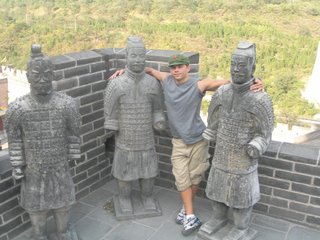
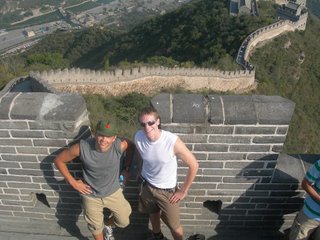

My buddy Victor is a tri-athlete at U of A, so we charged it together. We climbed the taller side first. It is amazingly steep! Some parts you are on all fours it is so steep. When we started I had my normal soft, girlish legs. By the half way point of the climb, my calves were made out of steel. By the time I reached the top, my ass was chiseled out of stone. No joke.
It took us about two hours to climb both sides. I can’t even grasp how hard it was to build this thing. Over one thousand miles is beyond my comprehension. Simply amazin
 g.
g. 


Chinese Food
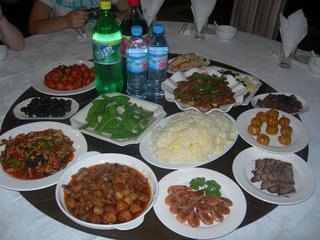
Chinese food tastes really good at first, but starts to wear on you after a couple of meals. They love their meat, and they love it with big chunks of fat on it. They also love thick oily sauces, and cooking eggs in with whatever they can. The best word to describe Chinese food is heavy. I think I ate enough animal fat in four days to last me the next five years.
There is also this pickled something that they serve at every meal. The smell from it is everywhere. It isn’t repulsive, but it definitely isn’t good. The funk gets in your clothes, in your nostrils and skin, and in your hair. I can still smell it in my dirty laundry bag from that trip.

Beijing
All my life I’ve been hearing people say stuff like “China, Japan, it’s all the same.” Let me tell you right now that they are very, very different places. Beijing has more in common with Tijuana than any Japanese city that I saw.
When flying into Beijing, all I could see was a brownish yellow haze. It wasn’t until we descended into the pollution cloud that we could actually see the city. The pollution is pretty out of hand, and the whole time I was in Beijing, the air tasted like I was sucking on an exhaust pipe.
We arrived at Peking University after dark. After dropping our stuff off in our rooms I headed out with two girls, Kim and Trish, to check out the surrounding area. It was a big shock. The streets were really dirty, and the walls and sidewalks were crumbling. We found our way down a fairly well lit alley that had lots of people walking around. The poverty was apparent right away. Most of the guys were shirtless and barefoot. Women were cooking skewers of meat over makeshift fires on the sidewalk. Filthy dogs wandered in and out of shops. Peo ple spit wherever they wanted to, and I saw a people spitting on the floors inside little shops.
ple spit wherever they wanted to, and I saw a people spitting on the floors inside little shops.
Unlike Japan, people walked fast, bumping into and pushing each other. I didn’t stand out too much, but the two blonde chicks I was with sure did. Thankfully the Chinese don’t stare, but they were definitely curious and were checking us out. I don’t know how this part of town stacks up against the rest of Beijing, but it was very poor. This was the first time on this trip that I have felt completely out of place. It was like a completely different world. I didn’t feel threatened, but I was definitely on edge and watching my back.
When we got toward the end of the street, there were pool halls set up under tarps tied to trees with lots of guys crowded under. As we walked by, a man was pissing on the sidewalk. The street got pretty dark, so we flipped a U-turn and headed back the way we came. The scene was bizarre to me, like something out of a dream. Being completely submerged in a place so foreign for the first time, and at night, was completely exhilarating. I realized right then how far away from home I really am.
When flying into Beijing, all I could see was a brownish yellow haze. It wasn’t until we descended into the pollution cloud that we could actually see the city. The pollution is pretty out of hand, and the whole time I was in Beijing, the air tasted like I was sucking on an exhaust pipe.
We arrived at Peking University after dark. After dropping our stuff off in our rooms I headed out with two girls, Kim and Trish, to check out the surrounding area. It was a big shock. The streets were really dirty, and the walls and sidewalks were crumbling. We found our way down a fairly well lit alley that had lots of people walking around. The poverty was apparent right away. Most of the guys were shirtless and barefoot. Women were cooking skewers of meat over makeshift fires on the sidewalk. Filthy dogs wandered in and out of shops. Peo
 ple spit wherever they wanted to, and I saw a people spitting on the floors inside little shops.
ple spit wherever they wanted to, and I saw a people spitting on the floors inside little shops.Unlike Japan, people walked fast, bumping into and pushing each other. I didn’t stand out too much, but the two blonde chicks I was with sure did. Thankfully the Chinese don’t stare, but they were definitely curious and were checking us out. I don’t know how this part of town stacks up against the rest of Beijing, but it was very poor. This was the first time on this trip that I have felt completely out of place. It was like a completely different world. I didn’t feel threatened, but I was definitely on edge and watching my back.
When we got toward the end of the street, there were pool halls set up under tarps tied to trees with lots of guys crowded under. As we walked by, a man was pissing on the sidewalk. The street got pretty dark, so we flipped a U-turn and headed back the way we came. The scene was bizarre to me, like something out of a dream. Being completely submerged in a place so foreign for the first time, and at night, was completely exhilarating. I realized right then how far away from home I really am.
Subscribe to:
Posts (Atom)
